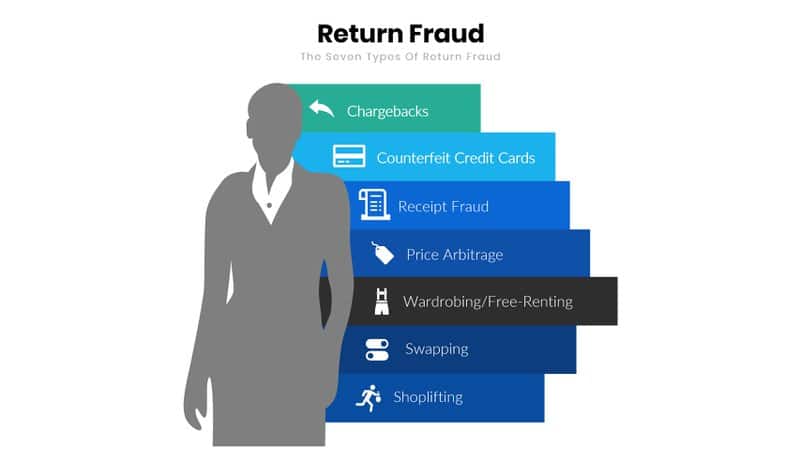Return fraud is the type of fraud where customers take advantage of a retail store's return policy to gain financially at their expense. This article explores the different return fraud tactics, the signs to watch out for, and the steps to protect your store.
If you're not familiar with return fraud, the best-known form of this abuse is "wardrobing" or "free renting." The customer makes a purchase, uses the product(s), and returns the merchandise after a few days.
Every e-commerce store owner desires to sell as many products as possible to increase profits. However, increased sales often come with an influx of customer product returns.
This can be due to customers receiving products that don't match their expectations, receiving damaged products, or changing their minds after receiving their products too late.
You, for sure, want to attend to your customer requests if they are genuine. That way you can build your customer equity and keep profiting from this relationship in the future.
However, not all customer returns are genuine. Some people intentionally engage in retail return fraud to gain financially from e-commerce businesses.
This article discusses what retail return fraud is, the different tactics consumers use to carry it out, the warning signs to look out for, as well as the things you can do to prevent it. Continue reading more below.
What is Retail Return Fraud?
Return Fraud is the type of fraud where customers take advantage of a retail store's return policy to gain financially at their expense.
You need to be aware of many tactics of carrying out retail return fraud to avoid becoming a victim. The most common ones include chargebacks, counterfeit credit cards, receipt fraud, price arbitrage, wardrobing/free-renting, swapping, and shoplifting.
Seven Return Fraud Tactics Fraudsters Use to Steal Money from E-commerce Stores

1) Chargebacks
This is where a consumer buys something from an e-commerce store, and then they contact their banks demanding a reversal of the transaction, claiming it's invalid.
Though consumers have genuine reasons to initiate credit card disputes, many others use this approach to get free items and money from online retail stores.
2) Counterfeit Credit Cards
This is a form of fraud where fraudsters use factual information from other peoples' stolen credit cards to make fake credit cards.
They use fake credit cards to make purchases in retail stores, then they return the products and ask the retailer to refund the money to a different credit card.
3) Receipt Fraud
This is where an individual shoplifts items from a retail store intending to return them later for a full refund using forged, stolen, or old receipts.
4) Price Arbitrage
This is where a consumer buys two similar-looking products with different prices, replaces the price tag on the cheap product with the expensive tag, and returns it to the store for a full refund.
Your eCommerce can prevent price arbitrage by scanning products correctly and not using easily removable stickers.
5) Wardrobing/Free Renting
This is where a consumer buys an item, uses it only once or twice with the price tag on, and returns it to get a full refund.
The most common items consumers wardrobe include dresses for special occasions, big-screen TVs for sporting events, video cameras for shooting weddings, and formal suits for interviews.
6) Swapping
This type of return fraud involves the consumer buying a new product with similar specifications as the damaged, broken, or old product they have at home and then they return the old/damaged product for a full refund.
The customer is always left enjoying their new product as your e-commerce business counts its losses.
7) Shoplifting
Shoplifting refers to the type of return fraud where an individual uses a valid receipt that has been stolen as their shopping list to find different items for shoplifting. Afterward, they initiate a return process, so they're refunded fully.
Let's now look at the warning signs of retail return fraud below:
Signs of Retail Return Fraud to Keep an Eye on
There are several ways to identify and track return frauds. Here are just some of them:
- High-priced products are being returned without receipts.
- A significant increase in the number of returns your store is getting.
- High rate of inventory shrinkage – This is a significant loss of inventory from one period of physical counting to another.
- Getting more returns, especially when only one employee is present at the store, i.e., very late in the evening or early in the morning immediately the store opens.
- Getting product returns from customers out of town.
Now that you understand the different ways fraudsters carry out retail return fraud and the warning signs to look out for, it's a good idea also to teach you how to protect your business from this type of fraud.
Here are a few tips you can use to minimize return fraud.
How To Minimize Return Fraud On Your E-Commerce Store
1) Have a Clear & Transparent Return Policy
Having a return policy with clear rules on product exchanges and returns is essential because it helps customers understand beforehand what your e-commerce store allows and what it doesn't allow.
So, make sure that your return policy is visible on your website, as well as on the customer's receipt, to discourage anyone thinking of committing return fraud.
It's worth pointing out that your return policy can only be effective at discouraging fraudsters if it's enforced consistently without making exceptions.
This means that you have to train your employees on what retail return fraud is, how it affects your business, and how to recognize the signs, so they can understand why they have to enforce your policy strictly and consistently.
2) Ask Customers to Provide Receipts Before Cash Refunds
Besides having a clear return policy, you should also require customers to produce receipts when returning products for a cash refund.
Receipts are essential in e-commerce because they allow you to check with your system if the customer bought the product from your store. This can go a long way in discouraging fraudulent returns if you implement it strictly and consistently.
3) Limit Returns to Between 15 and 30 Days
Also, when you provide an extended return period to your customers, you're giving them more time to devise new ways to commit fraudulent returns. Because of this, you need to set your return period anywhere from 15 days to 30 days.
4) Follow Up Return Requests With a Phone Call
This is important for separating genuine customers from fraudsters. A genuine customer will not have any problem answering your call to confirm that indeed they had a problem with their product and they'd like to return it for a refund.
And if you ask them some personal questions to confirm their identity, they'll gladly provide you with the information you need. However, scammers are more likely not to pick up your calls for fear of being found out. So, you'll know right away that their intentions are not genuine.
5) Introduce Restocking Fee for High-End Products
It would be best if you also considered introducing restocking fees for high-end products, as well as those that are difficult and expensive to ship.
This will discourage many customers who have the bad habit of returning products after using them for a short period since they'll not be willing to pay the fees to get cash refunds from your store.
6) Offer Equal Exchanges or Store Credits Instead of Cash Refunds
You can also minimize return fraud by limiting cash refunds as much as possible. To do this, consider offering customers store credits plus some discount when they return products for cash refunds.
Alternatively, you can allow them to exchange the product they're returning with another product of their choice, as long as the prices remain the same.
Both of these methods will help you keep your genuine customers happy and discourage those who want to steal from you.
7) Ban Fraudsters from Your Store
Lastly, you can curb return fraud by tracking customer accounts and banning those with too many return requests.
Types of Non-Fraudulent Returns
To remind us that non-fraudulent returns are more typical ones and the way you deal with them is extremely important to keep customer trust, these include:
- The Product was Defective or Damaged on Arrival
- The Customer No Longer Needs the Product
- The Items Arrived Too Late
- The Customer Received the Wrong Product from the Merchant
- The Product Didn't Meet the Customer's Expectations
- The Customer Changed Their Minds After Receiving the Product
- The Customer Purchased the Wrong Product
Now that you know why customers return products and the difference between a fraudulent and a non-frauded return, besides how to prevent them, it's time to take action. Implement the tips provided above to reduce your rate of return and protect your business.
Start Protecting Your Business From Return Fraud!
Fraudulent returns cost retail businesses billions of dollars yearly. Dishonest customers are continually devising new ways to take advantage of return policies provided by retail stores to steal money from them.
Because of this, you must learn the different tactics fraudsters use to commit return fraud and recognize the signs of this fraud in your store.
Above are several valuable tips to help you minimize return fraud and prevent your business from losing more money, so be sure to implement them.

Christian has over ten years of experience in marketing agencies. Currently, he has been dedicating his time to a tech startup and also writing for major publications. He loves podcasts and reading to keep up with the latest trends in marketing.
